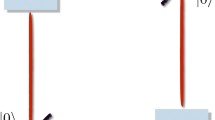Abstract
A fundamental particle in physical space subject to conservation of momentum and energy, and characterized by its average mass and its position is methodologically supplemented with an information processor – a classical Turing machine – and a randomizer both defined on an information space localized on every particle. In this way the particle can be considered a generalized Darwinian system on which natural selection could act steering the evolution on the information space of the algorithms that govern the behaviour of the particles, giving rise plausibly to emergent quantum behaviour from initial randomness. This theory is applied to an EPR-Bohm experiment for electrons in order to analyse Bell inequality violation. A model for the entanglement of two particles has been considered. The model includes shared randomness – each particle stores its own randomizer and that of its partner – and the mutual transfer of their algorithms – sharing programs – that contain their respective anticipation modules. This fact enables every particle to anticipate not only the possible future configurations of its surrounding systems, but also those of the surrounding systems of its entangled partner. Thus, while preserving locality and realism, this theory implies outcome dependence – through shared randomness – and parameter dependence – through shared anticipation – for entangled states and, as a consequence, the violation of the Bell inequality in an EPR-Bohm experiment.
Similar content being viewed by others
References
A. Shimony, in The Stanford Encyclopedia of Philosophy, Fall 2017 edn., edited by E.N. Zalta. Available at https://doi.org/plato.stanford.edu/archives/fall2017/entries/bell-theorem/
S.J. Freedman, J.F. Clauser, Phys. Rev. Lett. 28, 938 (1972)
E.S. Fry, R.C. Thompson, Phys. Rev. Lett. 37, 465 (1976)
A. Aspect, P. Grangier, G. Roger, Phys. Rev. Lett. 49, 91 (1982)
M. Giustina, M.A.M. Versteegh, S. Wengerowsky, J. Handsteiner, A. Hochrainer, K. Phelan et al., Phys. Rev. Lett. 115, 250401 (2015)
B. Hensen, H. Bernien, A.E. Dréau, A. Reiserer, N. Kalb, M.S. Blok et al., Nature 526, 682 (2015)
L.K. Shalm, E. Meyer-Scott, B.G. Christensen, P. Bierhorst, M.A. Wayne, M.J. Stevenset al., Phys. Rev. Lett. 115, 250402 (2015)
T. Maudlin, J. Phys. A: Math. Theor. 47, 424010 (2014)
K. Hess, H. De Raedt, K. Michielsen, https://doi.org/arXiv:1605.04889 (2016)
M. Kupczynski, Phys. Lett. A 116, 417 (1986)
A. Khrennikov, Theoret. Math. Phys. 157, 1448 (2008)
T.M. Nieuwenhuizen, Found. Phys. 41, 580 (2011)
L. de la Peña, A.M. Cetto, A. Valdés Hernández, The Emerging Quantum: The Physics Behind Quantum Mechanics (Springer, Berlin, 2015)
G. Groessing, S. Fussy, J. Mesa Pascasio, H. Schwabl, https://doi.org/arXiv:1403.3295 [quant-ph] (2014)
L. Vervoort, Found. Phys. 48, 803 (2018)
A. Whitaker, Am. J. Phys. 84, 493 (2016)
J. Bell, in The Ghost in the Atom, edited by P.C.W. Davies, J.R. Brown (Cambridge University Press, 1986), p. 73
G. ’tHooft, https://doi.org/arXiv:quant-ph/0701097 (2007)
L. Vervoort, https://doi.org/arXiv:1403.0145 [quant-ph] (2014)
R. Healey, in The Stanford Encyclopedia of Philosophy, Winter 2016 edn., edited by E.N. Zalta. Available at https://doi.org/plato.stanford.edu/archives/win2016/entries/quantum-bayesian/
L. Vaidman, in The Stanford Encyclopedia of Philosophy, Fall 2016 edn., edited by E.N. Zalta. Available at https://doi.org/plato.stanford.edu/archives/fall2016/entries/qm-manyworlds/
Y. Aharonov, S. Popescu, J. Tollaksen, Phys. Today 63, 27 (2010)
W. Mückenheim, Phys. Rep. 133, 337 (1986)
C. Baladrón, A. Khrennikov, in Quantum Foundations, Probability and Information, edited by A. Khrennikov, B. Toni (Springer, Cham, 2018)
D. Jennings, M. Leifer, Contemp. Phys. 57, 60 (2016)
F. Laudisa, Eur. J. Philos. Sci. 4, 1 (2014)
A. Khrennikov, Fortsch. Phys. 65, 6 (2017)
A.E. Allahverdyan, R. Balian, T.M. Nieuwenhuizen, Phys. Rep. 525, 1 (2013)
A.E. Allahverdyan, R. Balian, T.M. Nieuwenhuizen, Ann. Phys. 376, 324 (2017)
C. Baladrón, in Quantum Foundations and Open Quantum Systems, edited by T. Nieuwenhuizen, et al. (World Scientific, Singapore, 2015)
C. Baladrón, A. Khrennikov, BioSystems 150, 13 (2016)
C. Baladrón, Fortsch. Phys. 65, 6 (2017)
C. Baladrón, A. Khrennikov, Prog. Biophys. Mol. Biol. 130, 80 (2017)
D. Barker-Plummer, in The Stanford Encyclopedia of Philosophy, Winter 2016 edn., edited by E.N. Zalta. Available at https://doi.org/plato.stanford.edu/archives/win2016/entries/turing-machine/
S. Hossenfelder, https://doi.org/arXiv:1202.0720 [physics.hist-ph] (2012)
S. Wolfram, A New Kind of Science (Wolfram Media, 2002)
C.G. Timpson, https://doi.org/arXiv:quant-ph/0412063 (2004)
S. Goldstein, in The Stanford Encyclopedia of Philosophy, Fall 2016 edn., edited by E.N. Zalta. Available at https://doi.org/plato.stanford.edu/archives/fall2016/entries/qm-bohm/
T. Norsen, Am. J. Phys. 82, 337 (2014)
D. Bohm, Annales de l’I.H.P. Physique théorique 49, 287 (1988)
M.J.W.Hall, Phys. Rev. A 84, 022102 (2011)
A.J. Lotka, Proc. Natl. Acad. Sci. 8, 151 (1922)
A.N. Whitehead, Process and Reality (Macmillan, New York, 1929)
J.A. Wheeler, in Complexity, Entropy, and the Physics of Information, edited by W.H. Zurek (Addison-Wesley, Redwood City, CA, 1990)
L. Smolin, https://doi.org/arXiv:hep-th/0612185 (2006)
W.H. Zurek, Nat. Phys. 5, 181 (2009)
B.R. Frieden, Am. J. Phys. 57, 1004 (1989)
J.M. Honig, J. Chem. Educ. 86, 116 (2009)
S. Aerts, Int. J. Theor. Phys. 47, 2 (2008)
H. De Raedt, M.I. Katsnelson, K. Michielsen, https://doi.org/arXiv:1303.4574 [quant-ph] (2013)
H. De Raedt, M.I. Katsnelson, H.C. Donkerb, K. Michielsen, Ann. Phys. 359, 166 (2015)
J. Summhammer, Int. J. Theor. Phys. 33, 171 (1994)
J. Summhammer, https://doi.org/arXiv:quant-ph/0701181 (2007)
S. Perrard, M. Labousse, M. Miskin, E. Fort, Y. Couder, Nat. Commun. 5, 3219 (2014)
S. Perrard, E. Fort, Y. Couder, Phys. Rev. Lett. 117, 094502 (2016)
K. Chatterjee, A. Pavlogiannis, B. Adlam, M.A. Nowak, https://doi.org/hal-00907940(2013)
A. Valentini, J. Phys. A: Math. Theor. 40, 3285 (2007)
M. Asano, A. Khrennikov, M. Ohya, Y. Tanaka, I. Yamato, Quantum Adaptivity in Biology: from Genetics to Cognition (Springer, Heidelberg, Berlin, New York, 2014)
M. Asano, I. Basieva, A. Khrennikov, M. Ohya, Y. Tanaka, I. Yamato, Found. Phys. 45, 1362 (2015)
Author information
Authors and Affiliations
Corresponding author
Rights and permissions
About this article
Cite this article
Baladrón, C., Khrennikov, A. Bell inequality violation in the framework of a Darwinian approach to quantum mechanics. Eur. Phys. J. Spec. Top. 227, 2119–2132 (2019). https://doi.org/10.1140/epjst/e2019-800061-1
Received:
Revised:
Published:
Issue Date:
DOI: https://doi.org/10.1140/epjst/e2019-800061-1




